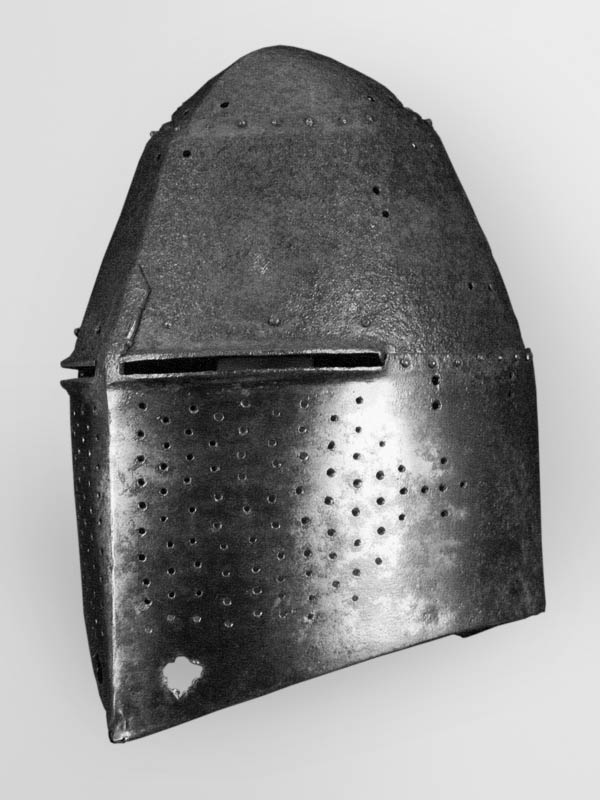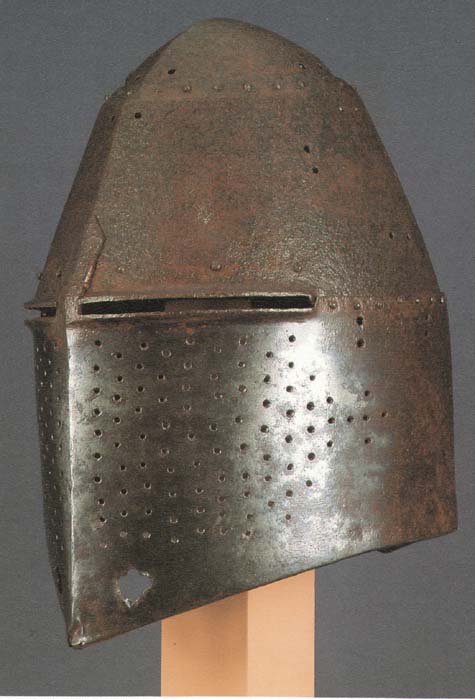| Author |
Message |
Chad Arnow
myArmoury Team


|
 Posted: Sat 27 Sep, 2008 8:56 am Post subject: Pembridge great helm question Posted: Sat 27 Sep, 2008 8:56 am Post subject: Pembridge great helm question |
 |
|
In one of my books, Howard Curtis's 2,500 years of European helmets, 800 B.C.-1700 A.D, the Pembridge helm is described as follows: "Originally this helmet was burnished in a beautiful glossy black color."

Anyone know how the blackening was done? Was it paint, forge blackening, a baked-on oil finish, etc.?
According to Alan Williams, this helm has been case carburised, so it was heated after it was completed. An oil finish could have been applied then, perhaps. Dr. Williams thinks the helm was heated for 2-3 hours at around 900 degrees to get the case hardening it has.
Anyone know for sure how the blackening was done? I think it's been shown paint was used in the 14th century, but other methods probably were, too.

ChadA
http://chadarnow.com/
|
|
    |
 |
Jared Smith

|
 Posted: Sat 27 Sep, 2008 12:34 pm Post subject: Posted: Sat 27 Sep, 2008 12:34 pm Post subject: |
 |
|
Honestly, I don't know how it really was done on any specific artifact.
The processes of case carburizing could have included encasing it in organic material (plant and animal skin matter...goat skin being a favorite) and then heating it (1300 to 1500 F.) This used to be done to create surface hardness for such things as metal files. When it is done that way, it naturally darkens the surface. Buffing without intentionally removing the surface layer (around 0.010 to 0.030 inches/fraction of a millimeter, depending upon hours or days of the treatment) could just leave a naturally darkened deep gun gray surface. Heat treating (heating and quenching in an oil), with a subsequent low temperature reheat could also have imparted a naturally darkened surface if a light oil (linseed or flax seed oil being historically plausible) had been used. Ideally, both of the carbeurizing and heat treatment steps would have been done with additive darkening enhancement.
Many previous posts have mentioned gently heating and applying beeswax/oil mixtures to burn off. I have not tried this. Present day blacksmith products include a beeswax compound for this very purpose. It is not supposed to be as durable as the natural darkening and oxidation depth that results from heat treating though.
Absence of evidence is not necessarily evidence of absence!
|
|
  |
 |
Chad Arnow
myArmoury Team


|
 Posted: Sun 28 Sep, 2008 7:30 am Post subject: Posted: Sun 28 Sep, 2008 7:30 am Post subject: |
 |
|
Here's a color picture of the Pembridge helm.
 Attachment: 47.1 KB Attachment: 47.1 KB


ChadA
http://chadarnow.com/
|
|
    |
 |
Randall Moffett

|
 Posted: Sun 28 Sep, 2008 11:50 am Post subject: Posted: Sun 28 Sep, 2008 11:50 am Post subject: |
 |
|
My guess from the look of the blackening is that it was whatever heat treatment done to it. You can even buy sheet steel that comes blackened with the black scale. A few bits of armour I worked hot last summer I left black because the neat colors of black and blue in it. I might have to polish it off sadly as they got wet with all the rain this summer and I did not notice and got rusted pretty bad.
RPM
|
|
  |
 |
James Arlen Gillaspie
Industry Professional

Location: upstate NY Joined: 10 Nov 2005
Posts: 587
|
 Posted: Sun 28 Sep, 2008 12:23 pm Post subject: Posted: Sun 28 Sep, 2008 12:23 pm Post subject: |
 |
|
The helm was perched over Sir Richard Pembridge's effigy in Hereford Cathedral till 1882. Dust collected on the top, the dust got moist from ambient humidity, heavy corrosion followed. Less dust collected on the vertical surfaces. Neglected, they still oxidized slowly over time. Steel items left to themselves in atmosphere will turn black, given long enough. It takes continual maintenance to keep them 'white'. A couple of decades of neglect, and the shining armour builds up a coating of hard black oxide. I have to deal with this problem all the time. Of couse, some armour was black to begin with, and we don't want to shine that stuff up! Sadly, that was done all too often. Bottom line, there may be no way to know if the helm was originally 'white' or not.
jamesarlen.com
|
|
   |
 |
|
|
You cannot post new topics in this forum
You cannot reply to topics in this forum
You cannot edit your posts in this forum
You cannot delete your posts in this forum
You cannot vote in polls in this forum
You cannot attach files in this forum
You can download files in this forum
|
All contents © Copyright 2003-2025 myArmoury.com — All rights reserved
Discussion forums powered by phpBB © The phpBB Group
Switch to the Basic Low-bandwidth Version of the forum
|

